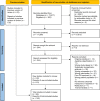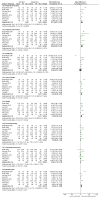Exercise-based cardiac rehabilitation for coronary heart disease: a meta-analysis
- PMID: 36746187
- PMCID: PMC9902155
- DOI: 10.1093/eurheartj/ehac747
Exercise-based cardiac rehabilitation for coronary heart disease: a meta-analysis
Abstract
Aims: Coronary heart disease is the most common reason for referral to exercise-based cardiac rehabilitation (CR) globally. However, the generalizability of previous meta-analyses of randomized controlled trials (RCTs) is questioned. Therefore, a contemporary updated meta-analysis was undertaken.
Methods and results: Database and trial registry searches were conducted to September 2020, seeking RCTs of exercise-based interventions with ≥6-month follow-up, compared with no-exercise control for adults with myocardial infarction, angina pectoris, or following coronary artery bypass graft, or percutaneous coronary intervention. The outcomes of mortality, recurrent clinical events, and health-related quality of life (HRQoL) were pooled using random-effects meta-analysis, and cost-effectiveness data were narratively synthesized. Meta-regression was used to examine effect modification. Study quality was assessed using the Cochrane risk of bias tool. A total of 85 RCTs involving 23 430 participants with a median 12-month follow-up were included. Overall, exercise-based CR was associated with significant risk reductions in cardiovascular mortality [risk ratio (RR): 0.74, 95% confidence interval (CI): 0.64-0.86, number needed to treat (NNT): 37], hospitalizations (RR: 0.77, 95% CI: 0.67-0.89, NNT: 37), and myocardial infarction (RR: 0.82, 95% CI: 0.70-0.96, NNT: 100). There was some evidence of significantly improved HRQoL with CR participation, and CR is cost-effective. There was no significant impact on overall mortality (RR: 0.96, 95% CI: 0.89-1.04), coronary artery bypass graft (RR: 0.96, 95% CI: 0.80-1.15), or percutaneous coronary intervention (RR: 0.84, 95% CI: 0.69-1.02). No significant difference in effects was found across different patient groups, CR delivery models, doses, follow-up, or risk of bias.
Conclusion: This review confirms that participation in exercise-based CR by patients with coronary heart disease receiving contemporary medical management reduces cardiovascular mortality, recurrent cardiac events, and hospitalizations and provides additional evidence supporting the improvement in HRQoL and the cost-effectiveness of CR.
Keywords: Cardiac rehabilitation; Coronary heart disease; Exercise training; Physical activity; Prevention.
© The Author(s) 2022. Published by Oxford University Press on behalf of the European Society of Cardiology.
Conflict of interest statement
Conflict of interest: N.O. declares being an author of a study that is eligible for inclusion in the work (funding source: European Society of Cardiology & European Association of Preventive Cardiology). D.R.T. declares being an author of a study that is eligible for inclusion in the work. A.D.Z. declares being an author of a study that is eligible for inclusion in the work.
Figures












References
-
- World Health Organization . The top 10 causes of death. https://www.who.int/news-room/fact-sheets/detail/the-top-10-causes-of-death (20 December 2022, date last accessed).
-
- Timmis A, Vardas P, Townsend N, Torbica A, Katus H, De Smedt D, et al. . European Society of Cardiology: cardiovascular disease statistics 2021. Eur Heart J 2022;43:716–799. - PubMed
-
- Smith SC Jr, Benjamin EJ, Bonow RO, Braun LT, Creager MA, Franklin BA, et al. . AHA/ACCF secondary prevention and risk reduction therapy for patients with coronary and other atherosclerotic vascular disease: 2011 update: a guideline from the American Heart Association and American College of Cardiology Foundation. J Am Coll Cardiol 2011;58:2432–2446. - PubMed
-
- Knuuti J, Wijns W, Saraste A, Capodanno D, Barbato E, Funck-Brenatno C, et al. . 2019 ESC guidelines for the diagnosis and management of chronic coronary syndromes: the task force for the diagnosis and management of chronic coronary syndromes of the European Society of Cardiology (ESC). Eur Heart J 2020;41:407–477. - PubMed
Publication types
MeSH terms
Grants and funding
LinkOut - more resources
Full Text Sources
Medical

